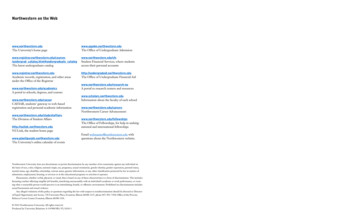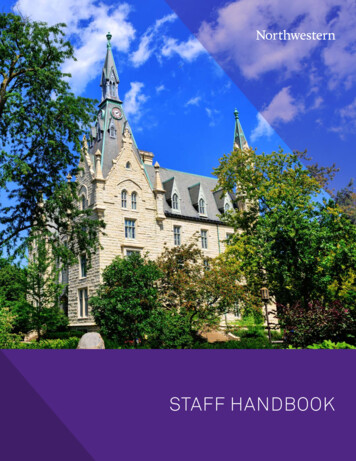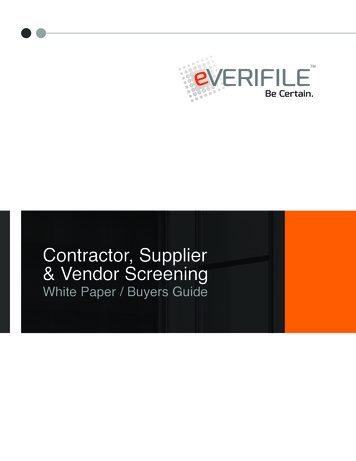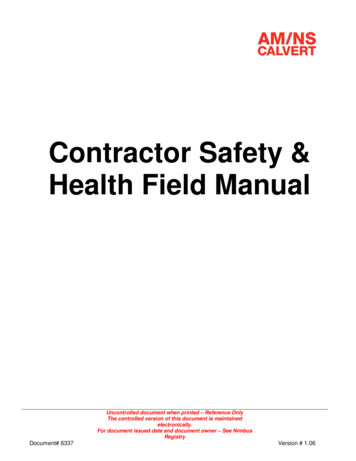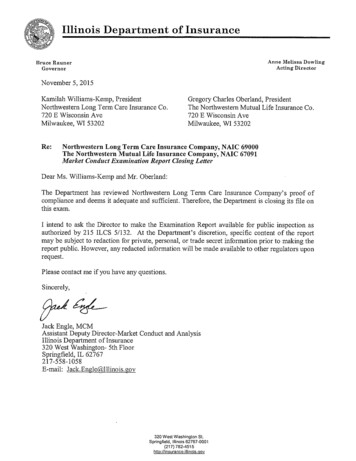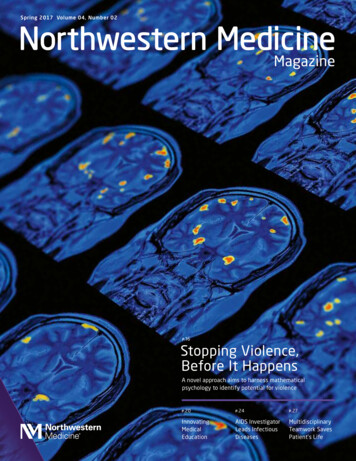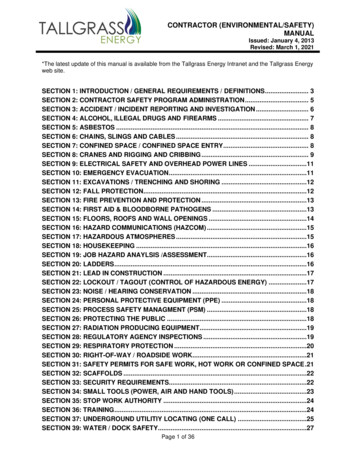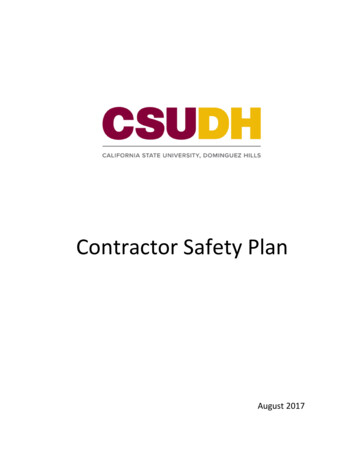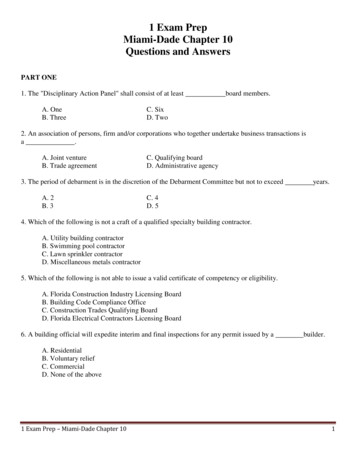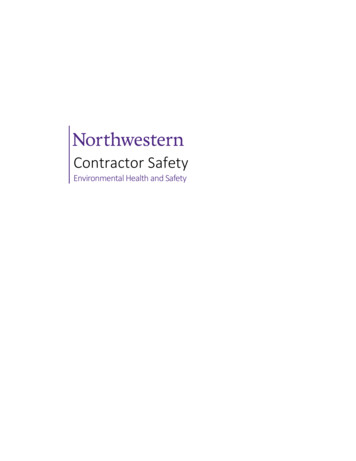
Transcription
Contractor SafetyEnvironmental Health and Safety
Table of ContentsI.Purpose . 2II.Scope . 2III. Responsibilities . 2IV. General Requirements . 3V.Specific Requirements . 4VI. Research Laboratory Access . 8VII. Incident Reporting . 8VIII. Recordkeeping . 9IX. Regulatory Authority. 9X.Contact . 9Contractor SafetyEnvironmental Health and Safety September 20211
I.II.PurposeThis program establishes minimum guidelines for safety and accident prevention duringconstruction, renovation, and maintenance activities at Northwestern University, in accordancewith Northwestern’s Environmental Health and Safety (EHS) Policy and programs.ScopeThe Contractor Safety Program applies to all contractors who perform construction ormaintenance activities on behalf of Northwestern. The term “Contractor” is to be construedliberally to apply to all vendors and service providers who perform on-site construction ormaintenance activities as identified below. For the purposes of this program, the term“Contractor” does not apply to subcontractors.Construction and maintenance activities include, but are not limited to: plumbing; electrical;carpentry; landscaping; telecommunications; recycling; elevator repair and maintenance;window washing; roofing; machinery/equipment installation or removal; crane operations; hotwork operations; utility plant services; heating, ventilation, and air conditioning work; custodialservices; painting; pest control; hazardous and universal waste handling and disposal; surveyand investigation activities; and other similar activities.Contractors retain primary responsibility for the safety of their worksites, employees, and safetyof any Northwestern staff, faculty, or students they may come in contact with. Contractors areaccountable for regulatory compliance, implementing effective safety programs, adequatetraining, and adherence to all reporting requirements.Contractors must coordinate all work with their Project Manager, which is defined as a theirmain point of contact for the work being performed on University property (e.g., NorthwesternChief Engineer, Chief Electrician, Project Manager, Building Manager, other UniversityRepresentative).III.ResponsibilitiesA. Contractorsi.Adhere to this program and Northwestern’s EHS Policy.ii.The person responsible for jobsite environmental health and safety mustcomplete Northwestern’s Contractor Safety Program online acknowledgement,at least every 3 years.iii.Contractors must be on Northwestern’s Approved Contractors List prior toconducting activities on campus.iv.Responsible for following their own safety and health program and complyingwith all federal, state, and local laws, in addition to any site-specificrequirements established in this program.v.Provide a safety representative or designate an individual responsible foraddressing worksite EHS concerns.vi.Depending on the nature of the work, submit a plan detailing the scope of workto EHS for review.vii.Ensure all employees have the proper knowledge and training (e.g., OSHA 10hour or 30-hour, the general safety requirements for the project, as well as anyContractor SafetyEnvironmental Health and Safety September 20212
task-specific training required) and access to required personal protectiveequipment. Proof of training must be available upon request.viii.Ensure all subcontractors adhere to safety and health requirements.ix.Report all incidents to Northwestern Project Managers and OSHA, if applicable.B. Northwestern University Project Managersi.Notify EHS of all incidents, injuries, and near misses.ii.Coordinate shutdowns, lockout/tagout, hot work permits, confined spaceentries, fire protection or detection system impairments, or any other tasksrequiring authorization, permitting, support, or intervention.iii.Partner with EHS to address environmental health and safety concerns.iv.Initiate the approval process for new contractors to add them to the contractorsafety program.v.Notify contractors of known hazardous conditions and provide site-specificinformation (e.g., confined space assessments, asbestos testing results, rooftopanchor certifications).vi.Contact the laboratory representative when work involves access intolaboratory spaces to obtain hazard information, personal protective equipmentrequirements, and any other critical information to ensure the work can beperformed safely.C. Northwestern University Environmental Health and Safety (EHS)i.Maintain the database of Contractor Safety Program acknowledgements andpersons responsible for jobsite environmental health and safety.ii.Maintain the Approved Contractors List and Pending Contractors List.iii.Provide guidance and technical assistance as needed, including assistance inreviewing and accepting contractor safety and work plans.iv.Review, audit, and revise this program annually.IV.General RequirementsThe following general requirements apply to all contractors subject to this program:A. Housekeepingi.Work areas, passageways, and doors must be maintained free of debris and hazardsto allow for unobstructed egress at all times.ii.Debris should be removed daily and eliminated in all areas where there is not anactive sprinkler system.iii.Separate waste containers must be maintained for waste, oily and used rags, andother flammable or hazardous wastes.B. Pandemic Safety Plans and Proceduresi.During public health crises (e.g., COVID-19), contractors must develop projectspecific safety plans and procedures that address guidelines and best practicesprovided by the Centers for Disease Control and Prevention (CDC) and theOccupational Safety and Health Administration (OSHA), and must be inaccordance with any ordinances and executive orders set forth by federal, state,or city governments.ii.Plans and procedures must comply with applicable Northwestern policies orprocedures and be implemented prior to the commencement of work.iii.Plans and procedures must be communicated to employees and any otheraffected personnel (e.g., subcontractors, Northwestern staff, faculty, students).Contractor SafetyEnvironmental Health and Safety September 20213
C. Site Safetyi.Have and adhere to a safety program applicable to the work being performed.ii.Establish and enforce site specific personal protective equipment requirementsfor all personnel, subcontractors, visitors, and Northwestern employees.iii.Worksites must have fire extinguishers readily available.iv.Smoking, including the use of electronic cigarettes and vaping, is prohibited inNorthwestern buildings, including buildings under renovation, and within 25feet of building entrances, as well as in designated outdoor facilities.v.Safety Data Sheets (SDS) must be readily available for all hazardous materialspresent at the worksite.vi.An emergency action plan must be developed for the worksite.vii.Do not prop or leave doors open in work areas when not attended.viii.On construction and renovation worksites, contractors must post a sign in aconspicuous location indicating the worksite EHS representative’s contact nameand phone number.D. Stop-Work Authorityi.Northwestern employees have the authority to stop work if unsafe acts orconditions are observed.ii.Contractors are required to stop work immediately if requested.iii.It is the responsibility of the contractor to take corrective actions to ensureconditions are safe prior to resuming work.V.Specific RequirementsThe following specific requirements apply to contactors subject to this program who areperforming work related to any of the following categories:A. Anti-Idling OrdinanceContractors must adhere to the City of Evanston’s Anti-Idling Ordinance while on theEvanston Campus and the City of Chicago’s Anti-Idling Ordinance while on the ChicagoCampus.B. AsbestosContractors must adhere to Northwestern’s Asbestos Management program whenservice, maintenance, or construction activities have the potential to encounter ordisturb asbestos containing material (ACM) or presumed asbestos containing material(PACM).C. Confined Spacesi.Notify the Project Manager prior to any activities involving confined spaces.ii.Contractors must have a program that meets or exceeds Northwestern’sConfined Spaces program and adhere to the Guidelines for Contractors Workingin Confined Spaces, which is an appendix of the program.iii.No entry may be performed until EHS and Facilities Operations evaluate thespace and identify the hazards, and communicate the evaluation to thecontractors.iv.The Project Manager must authorize the entry by signing and dating the entrypermit.v.For construction projects, adhere to OSHA construction standards and notify theProject Manager of the addition, removal, or change to confined spaces onNorthwestern property.Contractor SafetyEnvironmental Health and Safety September 20214
D. Control of Hazardous Energy (Lockout/Tagout)i.Contractors must coordinate all lockout/tagout activities with Project Managersand adhere to Northwestern’s Control of Hazardous Energy (Lockout/Tagout)program for all service and maintenance requiring the isolation and deenergization of hazardous energy sources.ii.All lockout/tagout activities must be completed in the form of grouplockout/tagout. Northwestern Facilities will shut down machines, equipment,and systems prior to any work beginning, then all parties will apply their locks.iii.Contractors are responsible for supplying their own locks and tags. Thesedevices must meet the requirements outlined in Northwestern’s Control ofHazardous Energy (Lockout/Tagout) program.E. Cranes and Riggingi.Contractor-controlled worksites must develop and implement a crane programthat meets or exceeds Northwestern and OSHA requirements.ii.Critical crane lift and logistics plans must meet the requirements ofNorthwestern’s Mobile Crane Critical Lift Operations Checklist and be submittedby Project Managers to EHS for review. Critical crane lifts are defined as:a. Hoisting loads 75% or more of the rated crane capacity,b. 2 or more cranes required to perform a lift,c. Movement of crane carriage with a load,d. Use of personnel platforms,e. Hoisting sensitive loads,f. Hoisting loads over occupied buildings,g. Hoisting loads outside construction areas, andh. Work involving encroachment on a public right-of-way.F. Dust/Odor ControlIn the event demolition and construction activities may potentially create dust andodors that adversely affect contractor personnel as well as people in adjacent areas,contractors must:i.Evaluate the spaces and areas they will be working in and identify hazards thatwill contribute to airborne particulates or odors.ii.Develop and implement a dust control plan.iii.Utilize the appropriate personal protective equipment for dust and particulaterelated work.iv.Identify and implement effective dust and odor control methods (e.g., water,ventilation, tools equipped with dust collection systems, sweeping compound,barriers) prior to the start of work.v.Monitor adjacent areas as work proceeds. Modify dust and odor controlmeasures if found to be ineffective.vi.When using products with crystalline silica, contractors must have a crystallinesilica exposure control plan.G. Electricali.All electrical work must be performed de-energized; if not feasible, contact EHS.ii.All electrical work must adhere to Northwestern’s Control of Hazardous Energy(Lockout/Tagout) program, where applicable.iii.Barrier or guard passageways, mechanical rooms, and other worksites whereelectrical work is being performed.H. Fall ProtectionContractor SafetyEnvironmental Health and Safety September 20215
i.ii.I.J.Contractors must adhere to Northwestern’s Fall Protection program.Establish and implement a fall protection plan, including rescue procedures,under the supervision of a competent person, and provide fall protection whenworkers will be exposed to fall hazards 4-feet or greater in height (e.g., roofingwork, steel erection).iii.Protect employees from fall hazards with the use of guardrails, gates, covers,personal fall protection systems, lifelines, or other effective means deemedappropriate to eliminate or reduce the hazard.Fire Detection and Protection Impairmentsi.Impairments to existing sprinkler systems, fire detection systems, fire pumps,special fire protection systems, or similar must be performed by Northwesternpersonnel.ii.Notify the Project Manager if any impairment is necessary.iii.When possible, plan impairments when the building or affected area is notoccupied.iv.Plan for temporary protection as necessary including, but not limited to, a firewatch and extra fire extinguishers.v.Hot work is prohibited while fire detection and protection systems are impaired.Exceptions must be submitted to the Project Manager and approved by EHS.Fire Preventioni.Generala. Contractors must adhere to Northwestern’s Fire Prevention program.b. Provide fire extinguishers appropriate for the conditions and hazardspresent in construction areas.c. Remove all trash and refuse from worksites daily.d. If a fire prevention deficiency is noted by EHS, the Project Manager, orother authority, work shall be stopped until the deficiency is addressed.e. Temporary heating devices on construction sites must be located atleast 10-feet from combustible materials (e.g., tarpaulins, canvas,similar coverings). Fresh air must be supplied in sufficient quantities tomaintain the health and safety of workers. Contractors must adhere tomanufacturer guidelines for safe use on worksites. Solid fuelsalamanders are prohibited in buildings and scaffolds.ii.Welding, Cutting, and Brazing (Hot Work)a. Contractors must adhere to Northwestern’s Welding, Cutting, andBrazing (Hot Work) program.b. Notify the Project Manager to request a hot work permit. Follow theinstructions and safeguards on the permit, and post the permit at thework site.c. A signed copy of the permit must be posted near the work site.d. Completed permits must be returned to the Project Manager.e. For renovations or work on existing buildings, coordinate with theProject Manager to verify fire protection systems are operational andavailable.f. Utilize a trained and competent fire watch with appropriateextinguishers for one hour after the completion of work.Contractor SafetyEnvironmental Health and Safety September 20216
K. Hazard Communicationi.Contractors must adhere to Northwestern’s Hazard Communication program.ii.Chemical inventories and SDSs must be readily available upon request.iii.Properly remove all unused and waste chemical products.L. Hazardous Waste/Universal Wastei.Contractors are responsible for all hazardous and universal waste on projectsand work sites and must adhere to Northwestern’s Hazardous Waste program.ii.Hazardous and universal waste must be labeled, handled, stored, and disposedof in accordance with applicable regulations.iii.Permits must be obtained when required (e.g., asbestos abatement) and a copyof the hazardous waste manifest must be provided to EHS.M. Material Handling Equipmenti.Contractors must adhere to Northwestern’s Material Handling Equipmentprogram.ii.Operators must be trained and authorized.iii.Material handling equipment must be inspected by the authorized operatorprior to operation.N. Mobile Elevated Work Platforms (MEWPs)i.Contractors must adhere to Northwestern’s Mobile Elevated Work Platformprogram.ii.Operators must be trained and authorized.iii.Mobile elevated work platforms must be inspected by the authorized operatorprior to operation.iv.A site risk assessment must be conducted prior to use and must include rescueplans.O. Portable Laddersi.Contractors must adhere to Northwestern’s Portable Ladder Safety program.ii.Responsible for supplying and using their own portable ladders.iii.Prohibited from using Northwestern portable ladders.iv.Users must be trained, applicable to the work being performed and portableladder type(s) used.P. Scaffolding and Job-Made Laddersi.Contractors must adhere to Northwestern’s Fall Protection program.ii.Erect and disassemble scaffolding under the direction of a competent person;scaffolding must support 4 times the intended load.iii.Employees must be protected from falling on scaffolds 4-feet or greater inheight.iv.Falling object prevention must be utilized including, but not limited to,guardrails, toeboards, netting, or barricading.v.Job-made ladders must be constructed and maintained to current ANSIstandards.Q. Trenching and Excavationsi.Notify the Project Manager prior to any trenching or excavation.ii.Adhere to all requirements of the Illinois Underground Utility Facilities DamagePrevention Act and OSHA 1926 Subpart P – Excavations.iii.Mark out the planned excavation site with white paint or flags (black whensnow is present).iv.The contractor performing the digging must contact JULIE by dialing 811 orContractor SafetyEnvironmental Health and Safety September 20217
(800) 892-0123. Utilities must be located at the worksite prior to the start ofwork.v.The Project Manager will provide written or verbal approval to commencedigging once utilities have been located and the contract betweenNorthwestern and the contractor is fully-executed.vi.Trenching and excavating activities must be performed under the supervision ofa competent person.vii.Identify material for protection of personnel (e.g., bracing, shoring, shielding,trench boxes) as determined by soil type.viii.Barricades must be in place to protect equipment, pedestrians, workers, andvehicles from fall hazards.R. Water IntrusionContractors must adhere to Northwestern’s Water Intrusion guide when responding toand/or are affected by water intrusion events on Northwestern property.S. Working On or Near Live Utilitiesi.Perform all utility work de-energized when possible.ii.If it is not feasible to perform the work on de-energized utilities, notify theProject Manager.iii.Northwestern authorization and safe operating procedures are required for allwork on or near live utilities.VI.Research Laboratory AccessA. Northwestern research laboratories may contain chemical, radiological, biological, laser,or magnetic field hazards. Spaces containing these potential hazards will have signagewhere applicable. It is imperative that contractors and subcontractors obey all signagerequirements, restrictions, and follow all protocols set forth by Northwestern to ensurea safe working environment at all times.B. Contractors must obtain authorization from a laboratory representative (e.g., principalinvestigator, lab manager, safety designate) prior to entry into any laboratory space andbefore any work can commence. If contractors are working under the direction of aNorthwestern Project Manager, the Project Manager is responsible for obtaining theaforementioned authorization for contractors prior to entry and commencement ofwork.C. Do not leave doors to research lab areas open/unsecured when not attended.D. Contractors are not to disturb or move any materials or equipment in the laboratoryspace unless a laboratory representative provides specific approval to carry out suchtasks.E. If hazardous or unexpected conditions become present in the laboratory space, stop allwork, exit the space, and notify Northwestern Research Safety (Evanston campus: 847491-5581, Chicago campus: 312-503-8300) and laboratory representative immediately.VII. Incident ReportingA. Contractors must reports all incidents (e.g., injuries, near misses, property damage) tothe Project Manager.B. Contractors must conduct incident investigations to determine root cause andcorrective actions and submit to EHS. EHS will contact the contractor with any questionsrelated to the investigation.Contractor SafetyEnvironmental Health and Safety September 20218
C. All contractors and subcontractors are responsible for cooperating with Northwesternincident investigations and reporting injuries, medical emergencies, fires, propertydamage, or any other reportable incidents to Northwestern and regulatory authorities,if applicable.D. All incidents, including near misses, must be reported within 24 hours.VIII. RecordkeepingNorthwestern and contractors must follow all regulatory requirements for recordkeeping.IX.X.Regulatory AuthorityNorthwestern and contractors will comply with the Occupational Health and SafetyAdministration’s (OSHA) standards and other applicable codes and standards.ContactFor questions, contact Environmental Health and Safety at ehs@northwestern.edu.Contractor SafetyEnvironmental Health and Safety September 20219
i. Adhere to this program and Northwestern's EHS Policy. ii. The person responsible for jobsite environmental health and safety must complete Northwestern's Contractor Safety Program online acknowledgement, at least every 3 years. iii. Contractors must be on Northwestern's Approved Contractors List prior to conducting activities on campus .
